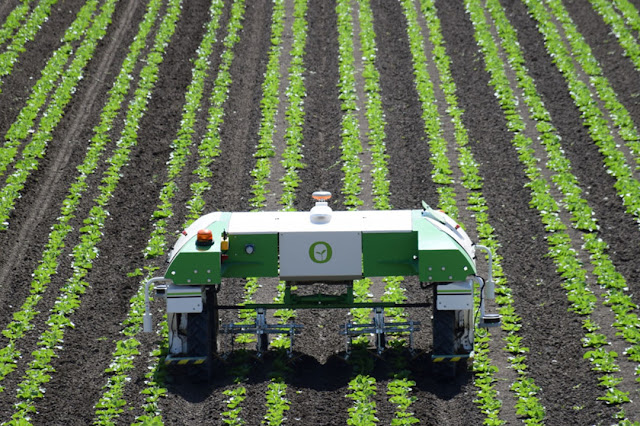Autonomous Vegetable Weeding Robots: The Future of Sustainable Agriculture
 |
| Autonomous Vegetable Weeding Robots |
Autonomous weeding robots hold great potential for the future of sustainable agriculture. By automating one of the most labor-intensive tasks in farming, they can help address issues like rising labor costs, lack of farmworkers, and the environmental impact of herbicide use.
Key Components and Technologies
At their core, autonomous weeding robots use computer vision systems and
machine learning algorithms to identify weeds and remove them without harming
crops. The key components and technologies that enable their Autonomous
Vegetables Weeding Robots functionality include:
Cameras - RGB and infrared cameras
provide visual data about the texture, color, shape and size of plants.
Sensors - Proximity sensors help
navigate tight crop rows and avoid obstacles. GPS provides positional data.
Computer Processing - Powerful
onboard computers analyze visual data in real-time using machine learning
models.
Robotics - Precise grippers,
rotating brushes or miniature plows remove weeds while avoiding crop damage.
Batteries - Lithium-ion or other
rechargeable battery types provide mobile power for several hours of operation.
Localization - Robot determines its
position using computer vision, sensor fusion and SLAM (simultaneous localization
and mapping) algorithms.
This fusion of computer vision, robotics, machine learning and sensor
technologies is what allows weeding robots to autonomously identify and remove
weeds with a high degree of accuracy and precision.
Benefits for Agriculture and the
Environment
The potential benefits of autonomous weeding robots fall into three main
categories: improved efficiency and productivity, reduced environmental impact,
and socioeconomic advantages.
In terms of efficiency, robots can weed 24/7 without fatigue. They offer
precise, timely weeding that maximizes crop yields. Fewer inputs like
herbicide, fuel and labor also lower production costs.
Environmentally, robots reduce chemical herbicide use by over 90% in many
cases. This lowers risks to ecosystem and human health. Less soil disruption
also preserves structure and microbiology.
Socioeconomic benefits include addressing farm labor shortages through
automation. Robots create high-skill jobs in robotics, AI and software instead
of low-wage seasonal work. They support more sustainable, profitable small
farms worldwide.
Applications in Different Crops
While still early in development, autonomous weeding robots are proving
effective in several major vegetable and row crops. Here is a brief overview of
their applications:
Carrots: Narrow crop rows make
vision-based weed detection and removal challenging for carrots. Early
prototypes show promise with over 80% weed removal rates.
Lettuce: Loose leaf lettuce
varieties have wide intra-row spacing ideal for robots. Systems from
Universities of California Davis and Plymouth consistently exceed 90% accuracy.
Strawberries: The low-growing habit
and dense planting of strawberries is well-suited for robotic weeding. Field
tests in Europe show high potential for this labor-intensive crop.
Soybeans: The large spacing between
soybean plants allows thorough coverage by machines. Field-testing has achieved
weed removal rates over 95% without damaging crops.
Research centers and startups are continuously working to expand successful
robot implementations to additional crops like tomatoes, peppers, broccoli and
more. As computer vision and robotics continue advancing, autonomous weeding
may become viable in most field-grown vegetables and row crops within this decade.
Ongoing Challenges and Hurdles
While holding great promise, autonomous weeding robots still face challenges
that researchers and engineers are actively working to overcome:
Cost - Initial development costs and
short payback periods remain hurdles for smallholder adoption worldwide.
Economies of scale could help reduce prices.
Environmental robustness - Varying
light, weather conditions, and complex row environments can reduce computer
vision performance requiring ongoing algorithm improvement.
System
integration - On-farm deployment demands reliable integration of
heterogeneous sensing systems, robotics, machine learning models and fleet
management capabilities.
Energy density - Maximizing battery
energy density is crucial to support weeding throughput over large areas on a
single charge without recharging delays.
Regulatory approval - Proving robots
pose no safety hazards to workers, public or environment will be necessary for
widespread commercial use.
However, with continuous progress in relevant enabling technologies like
computer vision, AI, robotics and power electronics, it is expected that
autonomous weeding robots will incrementally overcome all of these hurdles in
the coming decade, fulfilling their transformative potential for sustainable
agriculture globally.
Get more insights on Autonomous Vegetable Weeding Robots


Comments
Post a Comment